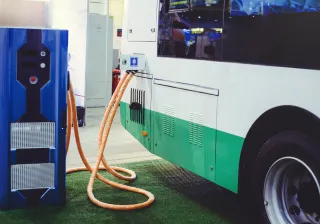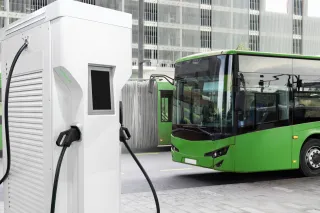Electrification of vehicles is expected to reduce greenhouse gas emissions and air pollution, while the growing pervasiveness of intelligent vehicles is likely to reduce traffic accidents and improve the availability of mobility services. However, private cars will continue to pose challenges to the sustainability of urban transport due to their inherent need for parking and road space. Without extensive transport system-level planning and guidance, passenger cars may account for an increasingly large share of urban space.
Currently, a significant proportion (30–60 %) of space in urban regions is covered by transport infrastructure. According to Statistics Finland, cars remain parked for over 90 % of the time in Finland. The share of transport infrastructure in a city has a significant impact on its attractiveness if it replaces public and green space, exacerbates urban sprawl, increases travel distances or creates other obstacles to equal mobility. This reduces the number of destinations accessible by walking, cycling and public transport, encouraging residents to drive an even larger share of their journeys with private cars. The result is increased congestion and space requirements for roads and parking in urban environments.
Transport sustainability strategies rely on increasing walking, cycling and the use of public transport in urban areas and reducing the use of private cars. However, due to the electrification of transport and the advancement of automation, counter-productive transitions from sustainable and space efficient modes of transport (e.g. walking, cycling and public transport) to private cars may pose challenges. System-level planning and guidance is needed to address these issues.
Transport transformations present both opportunities and challenges
The transition from internal combustion engines to electric cars offers a significant opportunity to reduce greenhouse gas emissions, improve air quality and reduce traffic noise in urban areas, while simultaneously improving the attractiveness of urban space. Even today, when low-carbon electricity is used in passenger cars in Finland, their life cycle CO2 emissions are only about a quarter of the emissions of a similar petrol car. The difference is even greater for heavy-duty vehicles. For improving air quality, the electrification of bus traffic in urban areas is even more important than passenger car traffic due to reduced harmful compounds and congestion. In this respect, electrification has progressed rapidly: many urban regions (e.g. Helsinki, Tampere and Kotka) have published public transport contracts including electric buses, and during the past year, one in two buses registered for the first time have been electric.
Transport will gradually become automated as technological development progresses. The automation of transport is expected to improve traffic safety, utilise more efficiently the road network and improve the mobility of individuals without private car, in particular. The automation of transport is expected to achieve significant road safety benefits as automated vehicles comply strictly with speed limits and traffic rules. They also help to reduce human errors of drivers, caused for instance by fatigue or distractions.
The transition to a fully automated road transport system can take decades, and the challenges associated with the transition period include traffic situations where conventional and automated vehicles and other road users interact with each other. At a low market penetration level of automated vehicles, the number of road accidents may even increase.
Vehicles that are independently responsible for the entire dynamic driving task are currently mainly in test and trial phases. In cities, vehicle automation has started with automated public transport (i.e. robot buses), which operate on predefined routes at low speeds. For example in Espoo, three new robot bus experiments started this autumn. Electrification and automation can potentially reduce the operating costs of public transport, enabling a denser public transport network and shorter headways. Advanced automation can even offer cost-effective, low-emission door-to-door transport on shared buses, thus improving the accessibility of public transport.
Electrification and automation are not the solution to the spatial demands of traffic. In urban environments, electric cars and automated vehicles can take up even more space than they currently do if the use of private cars is considered easier and cheaper than its alternatives. A further challenge is that these new technologies could even encourage more private car-oriented transport planning.
New mobility services, such as car and electric scooter sharing and Mobility-as-a-Service, MaaS, are best employed by supplementing existing modes of transport, thus promoting equal mobility opportunities. In addition, they are often marketed as sustainable modes of transport and as means of reducing the environmental load of transport as well as private car use. However, the services also have their downside. For example, it is currently unclear whether such new services will replace walking and cycling, private car use or the use of public transport, or whether they will generate entirely new trips. We Finns simply cannot afford a reduction in physical activity, as the annual direct health care costs caused by inactivity are EUR 600 million and societal costs between EUR 3,200 and EUR 7,500 million.
The performance targets of service providers also pose a challenge, as they aim for frequent use of the services and can therefore increase transport’s demand for urban space instead of reducing it, simultaneously bringing road safety and energy consumption issues. In addition, service provision often focuses on dense city centre areas, which generally already feature a large set of available modes. In contrast, the availability of services is poorer further away from city centres, where the coverage of public transport, for example, is weaker.
Active modes of travel are essential for promoting sustainable transport, attractive urban space and public health. This claim is supported by a large amount of international research data in both the transport and health sciences.
Based on international and domestic experiences, the best measures to promote walking, cycling and the transitions from motorised modes of transport to space saving active modes are:
- well maintained, high-quality routes
- transport network planning that considers all modes of transport equally
- provision of bicycle parking
- experiments encouraging the use of active modes of transport (e.g. at workplaces)
- sharing information about the benefits and opportunities of active modes of transport with residents and municipal decision-makers in particular
In the short term, the promotion of cycling has been estimated to be substantially more influential than electric cars in combating climate change, as the electrification of the car fleet takes a long time.
In recent years, many Finnish urban regions (e.g. Oulu, Joensuu and Helsinki) have taken measures to promote active modes of transport. Additionally, many major European cities, such as Paris and London, have also invested heavily in promoting cycling and increasing the attractiveness of urban space.
However, such endeavours have faced challenges. Measures cannot be implemented if the urban regions lack the capacity and resources required to implement them, i.e. transformative capacity. Key elements of transformative capacity include:
- visionary and committed actors, especially decision-makers
- systematic monitoring of the state of sustainable modes and future development plans
- pilot projects, learning from them and the operationalisation and sharing of the best practices
- administrative and cultural cross-border cooperation
The next step is to identify the combined effects
Electrification, automation and servitization are all major transitions in transport. Although they progress simultaneously, each has its own path. So far, little is known about the combined effects of the three major changes. The need for additional information and research on mutually reinforcing packages of measures is great, so that we can use these transitions to have a positive impact on the cross-cutting issues in society, such as climate change, air quality degradation and the safety, health and comfort of urban residents. Sustainable Urban Mobility Plans (SUMPs) are a concrete means of designing a more sustainable urban space that takes all future modes of transport into account. In Finland, the first plans have been created in Tampere, Lahti, Kotka and Vaasa. The future will show how the new design model can be integrated into the current design system. However, we're on the right path.
Authors:
Anu Tuominen, Anne Silla, Johannes Mesimäki ja Esko Lehtonen
References:
European Commission 2020. Determining the environmental impacts of conventional and alternatively fuelled vehicles through LCA. Final Report for the European Commission, DG Climate Action. Report prepared by Ricardo Energy & Environment.
Gössling, S. 2013. Urban transport transitions: Copenhagen, city of cyclists’. Journal of Transport Geography, 33, 196–206.
Götschi, T., Tainio, M., Maizlish, N., Schwanen, T., Goodman, A. & Woodcock, J. 2015. Contrasts in active transport behavior across four countries: How do they translate into public health benefits? Preventative Medicine, 74: 42–48.
Scheepers, C.E. 2010. Shifting from car to active transport: A systematic review of the effectiveness of interventions. Transportation Research Part A: Policy and Practice, Volume 70, December 2014, Pages 264–280.
Panter J., Guell C., Humphreys D. & Ogilvie D. 2019. Can changing the physical environment promote walking and cycling? A systematic review of what works and how. Health and Place 2019; 58:102161.







